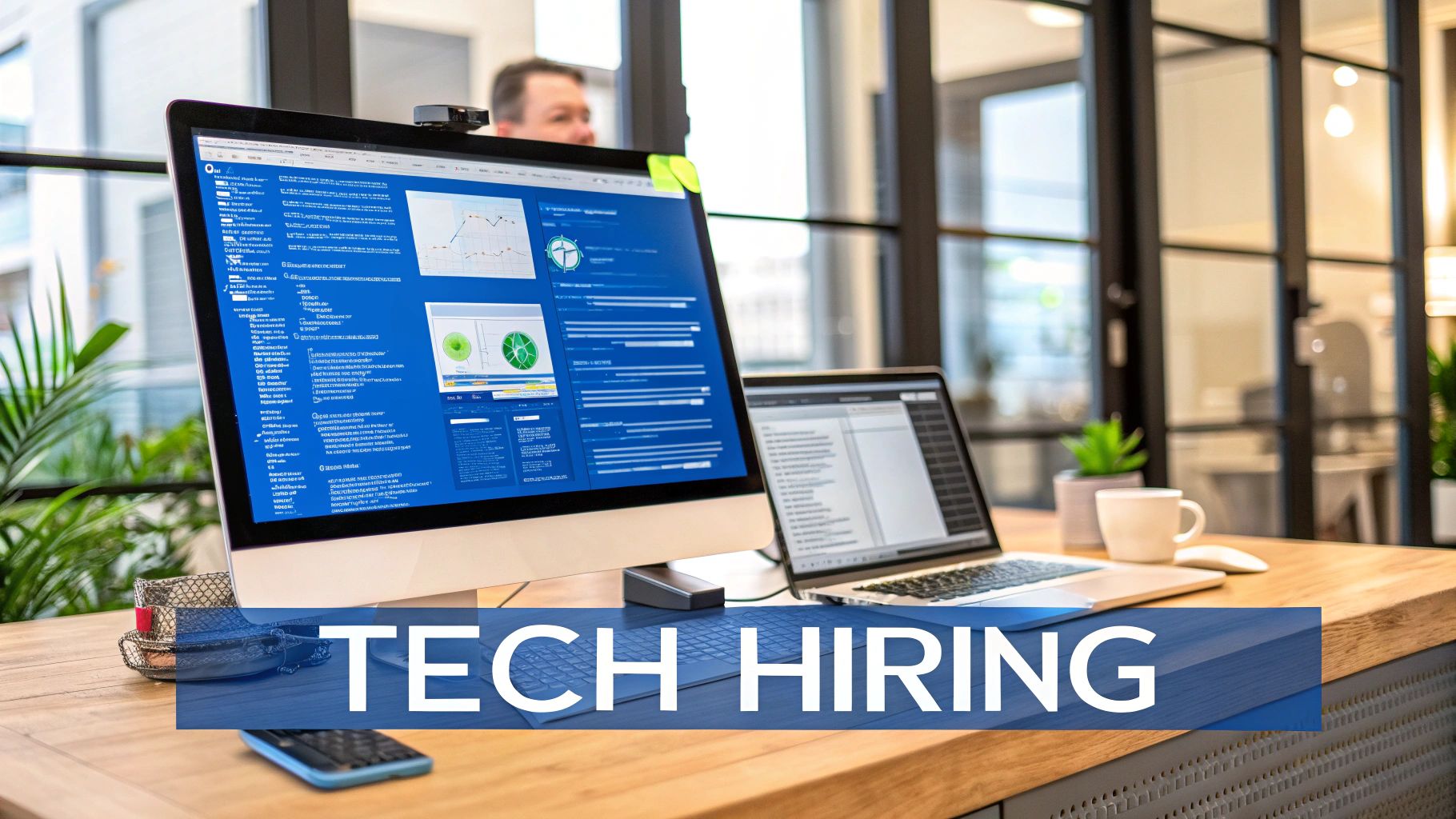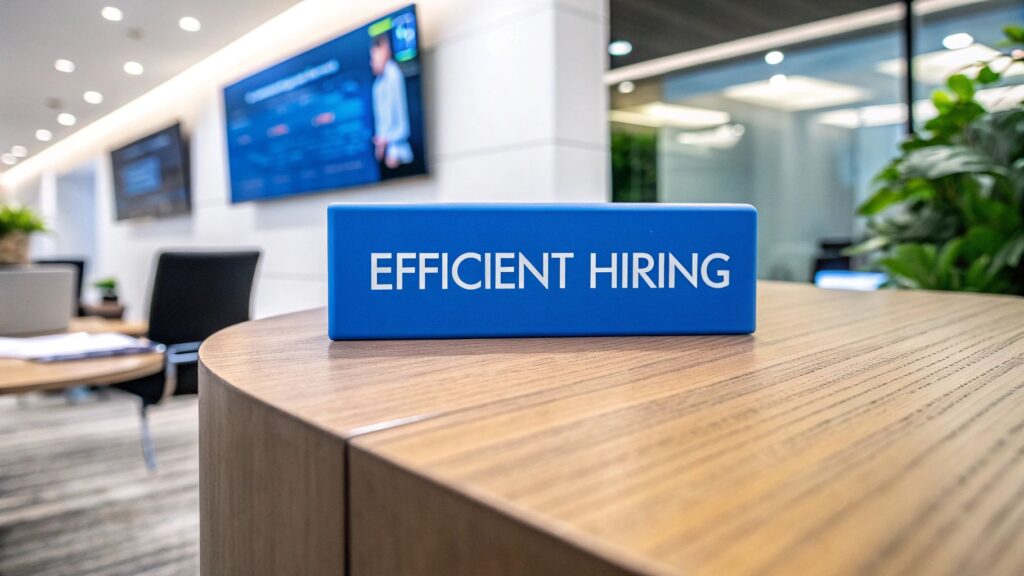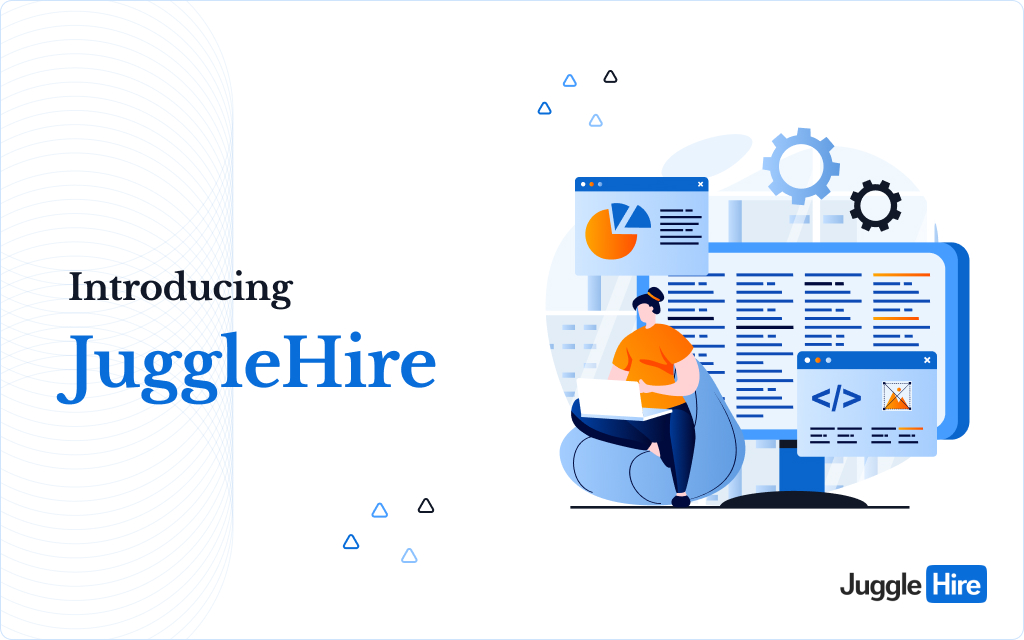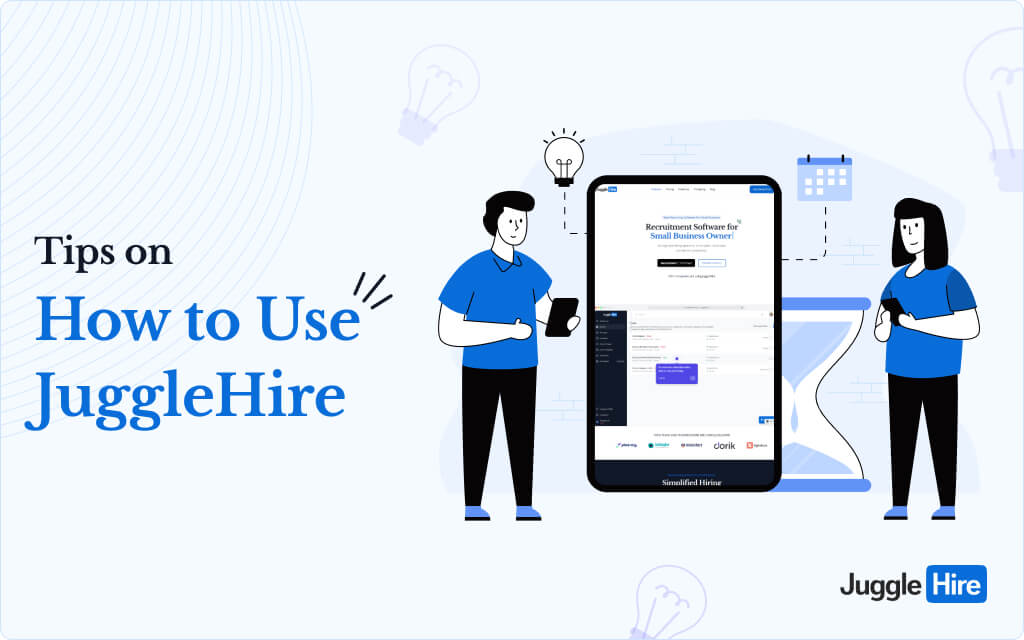Why Traditional Hiring Is Holding You Back

Outdated recruitment methods can seriously hinder your agency’s growth. They often result in extended vacancies, impacting your team’s productivity and ability to deliver projects on time. This can negatively affect both your bottom line and client satisfaction. Traditional processes also tend to increase costs-per-hire, as you spend more on advertising, recruitment agency fees, and internal resources. Ultimately, this makes it harder to stay competitive.
Lengthy application processes often discourage top-tier candidates. Highly skilled individuals have plenty of job opportunities. They won’t tolerate a complicated or frustrating application experience. They’re likely to abandon the process, leaving you with a smaller pool of less qualified applicants.
This means you’re missing out on the best people, limiting your team’s potential and impacting your agency’s overall growth.
The Impact of Inefficient Processes
Inefficient hiring processes manifest in several ways, wasting time, money, and potential. Here’s a breakdown:
- Lengthy Time-to-Fill: Extended vacancies lead to a backlog, putting a strain on existing employees and potentially delaying projects.
- High Cost-per-Hire: Traditional recruitment can be expensive, eating up resources that could be used elsewhere.
- Poor Candidate Experience: A negative application experience can tarnish your employer brand and discourage qualified candidates from applying in the future.
- Lost Productivity: Understaffed teams struggle to maintain optimal output, affecting overall business performance.
This is why streamlining your recruitment process is so important. Technology has made streamlining more critical than ever. Around 75% of recruiters now use an Applicant Tracking System (ATS) like Greenhouse to manage their recruitment processes, significantly improving efficiency. Learn more about these trends. This move toward automation is transforming how companies hire.
Streamlining for Success
Streamlining your recruitment process isn’t just about new technology; it’s about creating a strategic approach to hiring. It’s about attracting top talent, making informed decisions, and providing a positive candidate experience. A streamlined process can unlock your agency’s full potential, allowing you to compete effectively and secure the best talent. This leads to greater efficiency, reduced costs, and a stronger, more productive team.
Tech Tools That Transform Your Talent Acquisition

Outdated recruitment methods are a thing of the past. Today’s technology offers powerful tools to streamline the entire hiring process, helping you find better candidates quickly and efficiently. This section explores how the right technologies can reshape your talent acquisition strategy.
AI-Powered Candidate Matching
AI-powered candidate matching analyzes resumes and profiles far beyond simple keyword searches. These tools delve deeper, considering skills, experience, and even potential cultural fit. This intelligent matching helps recruiters quickly pinpoint top candidates, saving time and resources. Imagine an AI tool identifying a candidate with niche experience a recruiter might overlook with a traditional search. This targeted approach streamlines the application review process.
Automated Scheduling Tools
Eliminate those endless email chains for scheduling interviews. Automated scheduling tools integrate with calendars, empowering candidates to choose interview slots that work for everyone. This eliminates back-and-forth communication, freeing up recruiters for more strategic tasks. Plus, it provides a positive candidate experience by offering scheduling flexibility.
Video Platforms For Enhanced Engagement
Video platforms offer more than just remote interviewing; they provide a deeper understanding of a candidate. By seeing a candidate’s personality and communication style, recruiters gain insights often missed in traditional resumes. This leads to more informed hiring decisions that go beyond the limitations of a paper application. Video interviews also add flexibility for both candidates and recruiters.
Check out our guide on How to master the basics of technical SEO and content marketing for a wider perspective.
Building Your Recruitment Tech Ecosystem
Choosing the right tech tools is crucial for an efficient recruitment process. Here’s what to consider when building your recruitment technology ecosystem:
- Integration: Choose tools that integrate with existing systems, like your Applicant Tracking System (ATS) and Customer Relationship Management (CRM) software. This prevents data silos and ensures smooth information flow.
- Scalability: As your organization grows, so will your needs. Select platforms that can adapt and scale accordingly.
- User-Friendliness: Choose tools that are easy for both recruiters and candidates to use. A complex system can lead to frustration and inefficiency.
- ROI: Evaluate the potential return on investment for each tool. Consider time saved, cost reductions, and the quality of hires.
To help you choose the right tools, we’ve compiled a comparison of leading recruitment technologies.
The following table provides a comprehensive comparison of leading recruitment technology solutions across key features and benefits. It highlights the strengths of each technology type and offers guidance on selecting the best fit for your organization.
Top Recruitment Technologies Comparison
| Technology Type | Key Features | Best For | Implementation Time | ROI Potential |
|---|---|---|---|---|
| AI-Powered Matching Software | Intelligent candidate matching, skills gap analysis, automated screening | High-volume hiring, niche roles | 2-4 weeks | High, through reduced time-to-fill and improved quality of hire |
| Automated Scheduling Tools | Calendar integration, self-service scheduling, automated reminders | All recruitment scenarios | 1-2 weeks | Medium, through increased recruiter efficiency |
| Video Interviewing Platforms | Live and recorded interviews, integrated assessments, candidate feedback tools | Remote hiring, initial screening | 1-2 weeks | Medium, through expanded talent pool and reduced travel costs |
By considering these factors and exploring the diverse options available, you can select the best technology to meet your specific requirements.
By strategically integrating these tools, you can build a recruitment process that attracts and secures top talent. This transformation supports your agency’s growth and strengthens your competitive edge.
Mastering Social Recruitment That Actually Converts

Social media is more than just posting job links. It’s a powerful tool for enhancing your recruitment process. It’s about connecting with potential candidates where they are already spending their time and nurturing relationships that can turn into applications. This means understanding each platform’s unique strengths and creating content that truly resonates with your target audience.
Platform-Specific Strategies for Engagement
Every social media platform offers unique advantages. LinkedIn is excellent for professional networking and connecting with passive candidates. Twitter allows you to share company updates and quick job announcements. Instagram is perfect for showcasing your company culture and appealing to younger talent.
Tailoring your content to each platform is crucial. A formal job posting may be effective on LinkedIn, but a behind-the-scenes glimpse of your team might be more engaging on Instagram. Understanding the strengths of each platform helps you efficiently connect with the right candidates.
You might be interested in: How to master platform specific strategies.
Content That Captures Attention
Creating compelling content on social media is essential for attracting the best talent. Think about what makes your company unique. Showcase your company culture, values, and employee stories to give a genuine impression of what it’s like to work for you.
Share employee testimonials, post photos of team events, or highlight exciting projects. This offers potential candidates a peek into your company’s personality. Sharing your expertise through thought leadership articles and industry insights positions your company as a leader in its field, attracting those who are eager to learn and contribute. This genuine engagement can significantly boost your employer branding.
Social media is vital in today’s recruitment landscape, helping you connect with passive candidates and build your brand. Platforms like LinkedIn and targeted campaigns are increasingly important for finding and engaging potential hires, making the process more effective through wider reach and personalized interactions. Explore this topic further.
Measuring Social Recruitment ROI
Measuring the effectiveness of your social recruitment is essential. While likes and shares are positive indicators, they don’t provide a complete picture. Focus on metrics that directly impact your hiring pipeline.
- Application Source: Track the number of applications originating from each social platform.
- Conversion Rate: Measure the percentage of social media interactions that result in applications.
- Time-to-Fill: Analyze how social recruitment affects the time it takes to fill open positions.
- Cost-per-Hire: Evaluate the cost-effectiveness of acquiring talent through social media compared to other methods.
By monitoring these key performance indicators (KPIs), you gain valuable data about what’s working and what needs adjustment. This data-driven approach ensures your social recruitment strategy is efficient and contributes to a more streamlined hiring process. This focus on continuous improvement will optimize your efforts over time.
Crafting a Candidate Experience Worth Talking About

Attracting top-tier candidates is just the first step. The real test lies in creating a candidate experience so remarkable that they pick your company over others. This involves carefully evaluating every interaction a candidate has with your organization, from their first glimpse of the job posting to the final offer. A thoughtfully designed candidate experience is essential for a smooth and efficient recruitment process.
Simplifying Without Sacrificing Quality
Streamlining your recruitment doesn’t mean taking shortcuts. It means making the application process easier without compromising the quality of your evaluation. Consider using tools like JuggleHire to build concise, user-friendly application forms that efficiently collect essential information.
For instance, integrating pre-populated fields or enabling direct resume uploads can significantly reduce the time and effort involved in applying. This simplified approach can boost application completion rates and ensure you don’t overlook qualified candidates deterred by a cumbersome process.
Communication Is Key
Consistent communication is vital, particularly during longer hiring cycles. Regular updates keep candidates informed and engaged, lessening anxiety and preventing them from withdrawing from the process. This could involve automated email updates via JuggleHire or personalized messages from your recruiters.
This communication fosters transparency and shows respect for the candidate’s time. It also reflects positively on your employer brand, enhancing your company’s attractiveness to potential hires.
Personalization at Scale
Personalizing the candidate experience can substantially improve engagement, even with high-volume recruitment. This doesn’t necessitate individual emails to each applicant. Instead, consider using JuggleHire to segment candidates based on their skills or experience, tailoring communications accordingly.
Providing personalized feedback, even to unsuccessful candidates, demonstrates respect and professionalism. These small actions can make a lasting positive impression, encouraging candidates to consider your company for future openings.
Measuring and Improving the Experience
Gathering feedback is crucial for ongoing improvement. Tools like JuggleHire can automate feedback requests at various stages of the recruitment process. This invaluable feedback can highlight areas for improvement, allowing you to refine your approach and create a more effective, candidate-focused process.
Tracking metrics like application completion rates, time-to-fill, and offer acceptance rates offers quantitative data on the success of your strategies. Consistently analyzing and acting upon this feedback ensures your candidate experience is a valuable asset in your recruitment strategy.
Tracking Candidate Experience Metrics
To monitor your progress and pinpoint areas for improvement, use a table like the “Candidate Experience Metrics Tracker” below. This table outlines key metrics to track throughout the recruitment process, providing industry benchmarks and suggesting potential improvement strategies.
| Recruitment Stage | Metrics to Track | Industry Benchmarks | Improvement Strategies |
|---|---|---|---|
| Application | Completion Rate | Aim for >80% | Simplify application form, offer mobile-friendly options |
| Screening | Time-to-Screen | Target <5 days | Use automated screening tools, clear criteria |
| Interview | Candidate Satisfaction | Strive for >4.5/5 | Prepare interviewers, provide clear communication |
| Offer | Acceptance Rate | Aim for >75% | Competitive compensation, strong employer branding |
By focusing on these essential elements, you can create a candidate experience that not only streamlines your recruitment but also strengthens your employer brand and attracts top-tier professionals. This positive experience creates a beneficial cycle, making it easier to attract, engage, and ultimately hire the best individuals for your agency.
Building Recruitment Workflows That Actually Work
Effective recruitment isn’t a matter of chance; it’s about having well-defined workflows. These workflows help eliminate bottlenecks and create a smooth, efficient hiring process. This involves mapping your existing recruitment process, identifying problem areas, and establishing structured procedures. These procedures need to maintain consistency while also allowing flexibility for various roles.
Mapping Your Recruitment Journey
Begin by visualizing your current recruitment process. Outline each step, from the initial job posting to extending the final offer. Where are the hold-ups? At what points do candidates drop out of the process? For example, is your application process overly complicated? Are your interviews inconsistent and lacking structure? Identifying these friction points is crucial for improving your recruitment efforts.
Aligning Stakeholders
Recruitment often involves multiple stakeholders, each with different priorities. Hiring managers might focus on how well a candidate fits within the team, while executives may prioritize cost-related metrics. It’s important to align these perspectives. This could mean developing a shared understanding of ideal candidate profiles or agreeing on acceptable time-to-fill targets. Creating clear communication channels and regular feedback loops helps prevent misalignment and keeps everyone focused on a common goal.
Establishing Clear Criteria and Service Level Agreements
Each stage of the recruitment process should have well-defined criteria for advancement. This promotes transparency and consistent evaluation. For instance, define the specific skills and experience required for a candidate to move from the application review stage to the interview stage. Also, establish service level agreements (SLAs). These agreements define timelines for each step, promoting accountability without unnecessary red tape. A typical SLA might state that candidates receive interview feedback within 48 hours.
Implementing Effective Communication Protocols
Maintaining consistent communication is vital for a positive candidate experience. Create protocols that keep candidates informed throughout the entire hiring process. This could include automated updates through JuggleHire or personalized messages from recruiters. For example, acknowledge application receipt immediately and provide regular updates on the hiring timeline. This helps maintain momentum and prevents candidates from withdrawing due to a lack of communication. Read also: How to master workflow creation.
Adaptable Workflow Templates
Implementing structured workflows shouldn’t restrict flexibility. Create adaptable templates that cater to different organization sizes and hiring volumes. A small startup will likely have a simpler process compared to a large corporation. JuggleHire allows for customization, ensuring your workflows match your unique requirements. This involves tailoring the steps, communication, and evaluation criteria to each individual role and circumstance. This balanced approach promotes efficiency while maintaining a personalized candidate experience. By concentrating on these key aspects, you can create recruitment workflows that deliver results, attracting and securing top talent efficiently.
Turning Recruitment Data Into Decisive Action
Data-driven recruitment is reshaping how companies find, assess, and hire top talent. It’s about going beyond intuition and using concrete data to make smarter decisions. This means knowing which metrics truly matter, from basics like time-to-hire to more nuanced quality indicators that predict candidate success.
Identifying Key Recruitment Metrics
Not all data is equally valuable. Some metrics offer richer insights than others. Time-to-hire remains a fundamental metric, reflecting how efficient your process is. However, an exclusive focus on speed can compromise quality. Other important metrics include:
- Source of Hire: Knowing where your best hires come from lets you focus recruitment efforts on the most effective channels. For instance, if employee referrals are your strongest source, investing in a solid referral program is a smart move.
- Cost-per-Hire: This metric helps you assess the financial effectiveness of your various recruitment strategies. Tracking cost-per-hire allows you to optimize spending and get the best return on investment.
- Quality of Hire: This often-overlooked metric is vital for long-term success. It gauges how well a new hire performs and contributes to the company. Tracking quality of hire helps you refine your recruitment strategies to find people who will thrive in your organization.
Using Data to Predict Future Hiring Needs
Data can help you anticipate future talent needs. By analyzing past hiring trends and considering projected growth, you can forecast future hiring needs with impressive accuracy. This proactive approach lets you start building talent pipelines before positions even open, giving you a competitive advantage.
For example, if you plan to enter a new market, analyzing the necessary skills and experience for success in that market lets you proactively find and connect with potential candidates.
Building Actionable Dashboards
Data is only as good as its accessibility and clarity. Creating dashboards that visualize key metrics is crucial. Tools like JuggleHire allow you to build custom dashboards that track your most important KPIs. This allows you to see trends, identify problems, and make informed decisions quickly. These dashboards should be built to drive action, not just gather data.
Learn more in our article about How to establish meaningful benchmarks.
Balancing Data with Human Judgment
While data is incredibly valuable, it shouldn’t replace human judgment. Data informs decisions, but human insight is still essential, especially when considering cultural fit and soft skills. This balance ensures you aren’t relying solely on algorithms, which can sometimes perpetuate bias.
Eliminating Algorithmic Bias
Algorithms can sometimes reinforce existing biases, especially if the training data itself reflects those biases. This can undermine diversity and inclusion efforts. Carefully evaluating the data used to train algorithms is key to ensuring your recruitment technology promotes fairness and equal opportunity. For example, if your past hiring data shows an overrepresentation of one demographic, your algorithms might unintentionally continue that imbalance. Awareness of these pitfalls is crucial for building a fair and equitable recruitment process. Combining data-driven insights with careful human oversight creates a strong recruitment strategy that attracts, engages, and secures top talent for your company.
Your 90-Day Plan for Recruitment Transformation
Transforming your recruitment process isn’t about instant overhauls. It’s about implementing practical strategies that deliver lasting results. This phased approach, spanning 90 days, focuses on quick wins to build momentum while laying the groundwork for long-term success.
Phase 1: Quick Wins (Days 1-30)
This initial phase concentrates on optimizing your current processes for immediate improvements. Focus on identifying and addressing the most significant bottlenecks in your existing recruitment workflow.
- Audit Your Current Process: Map your current recruitment journey, identifying areas of friction like lengthy application forms or inconsistent communication. For example, if your application process takes more than 15 minutes, simplify it for faster completion.
- Optimize Job Postings: Ensure your job descriptions are clear, concise, and compelling, accurately reflecting the role and company culture.
- Improve Communication: Implement automated acknowledgment emails and regular status updates to enhance the candidate experience. This shows respect for applicants’ time and keeps them engaged.
These first steps build a foundation for larger changes in the following phases. They also demonstrate a commitment to improvement, which encourages buy-in from stakeholders.
Phase 2: Building Momentum (Days 31-60)
With initial improvements implemented, this phase focuses on integrating technology and refining core processes.
- Implement Key Technologies: Introduce tools like JuggleHire to automate tasks such as scheduling, candidate communication, and reporting. This frees up recruiters to concentrate on strategic activities.
- Refine Interview Processes: Standardize interview questions and implement a structured scoring system to mitigate bias and improve decision-making.
- Develop a Candidate Feedback Mechanism: Gather candidate feedback to identify areas for improvement, demonstrating to applicants that their input is valuable.
By incorporating these elements, you create a more efficient and candidate-centric process. This builds upon the momentum of the first phase, showcasing tangible progress and reinforcing stakeholder support.
Phase 3: Long-Term Transformation (Days 61-90)
This final phase establishes long-term strategies for continuous improvement and data-driven decision-making.
- Data Analysis and Reporting: Use JuggleHire’s reporting features to analyze key metrics, such as time-to-fill and cost-per-hire. This data-driven approach informs future recruitment strategies.
- Refine and Automate Workflows: Based on the data analysis, fine-tune workflows and automate additional tasks for maximum efficiency. For example, automate candidate sourcing from different platforms.
- Continuous Improvement: Establish a feedback loop for ongoing process refinement, ensuring your recruitment strategy remains adaptable and effective.
This focus on continuous improvement ensures your recruitment process evolves with your organization’s needs. By consistently analyzing data and adapting strategies, you establish a recruitment process that yields exceptional results.
Transform your agency’s recruitment process with JuggleHire. Experience the difference today!


